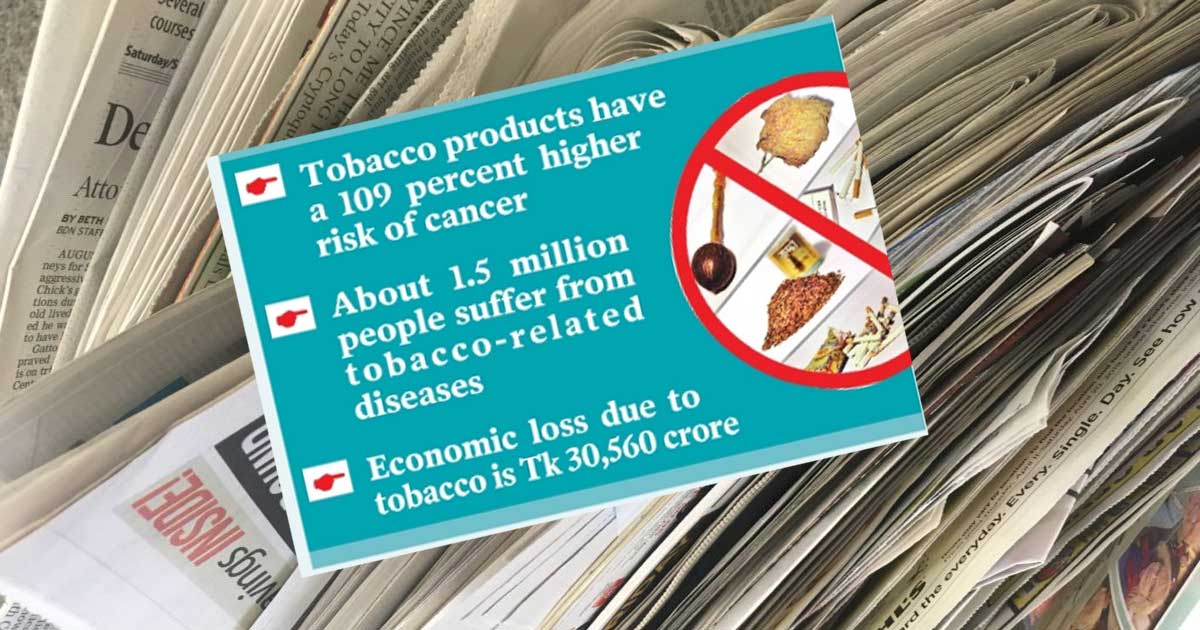- Tobacco products have a 109 percent higher risk of cancer
- About 1.5 million people suffer from tobacco-related diseases
- Economic loss due to tobacco is Tk 30,560 crore
Most of the deaths in Bangladesh are due to non-communicable diseases. According to the World Health Organization report, 67 percent of the total deaths in Bangladesh every year are due to non-communicable diseases. The main causes of these diseases include excessive use of tobacco and tobacco products. The total number of deaths due to non-communicable diseases in Bangladesh annually is 5 lakh 72 thousand; of these, 161,000 died directly due to tobacco-related diseases.
According to the World Health Organization report, one patient from non-communicable diseases dies every two seconds in the world. These non-communicable diseases such as heart disease, cancer, diabetes, kidney disease, respiratory diseases kill 15 million people every year, who are between the ages of 30 and 69. Eighty-five percent of these premature deaths occur in low- and middle-income countries. Bangladesh is notable among them. Officials say that non-communicable diseases are enough to shake the economic foundation of an entire family, not just physically.
Even now, the financial resources of the people of the country are not enough for the treatment of non-communicable diseases. Therefore, tobacco control is necessary to prevent these diseases to protect public health. Reports of Global Adult Tobacco Survey Bangladesh 2017, Global Youth Tobacco Survey Bangladesh 2013, Tobacco Atlas 2020 and Bangladesh Cancer Society and American Cancer Society Research have revealed a grim picture of tobacco use in the country.
According to the reports, 35.3 percent of people aged 15 years and above use tobacco in the country. The rate of tobacco use among men in this age group is 46 percent, while among women it is 25.2 percent. On the other hand, 18 percent of adults smoke and 20.6 percent of adults use smokeless tobacco (zarda, gul, white leaf, etc.).
Among 13- to 15-year-olds, 6.9 percent use some form of tobacco. The rate of tobacco use among boys in this age group is 9.2 percent, while among girls it is 2.8 percent. On the other hand, 4 percent of boys and 1.1 percent of girls in this age group smoke. The number of smokers in this age group is 5.9 percent among boys and 2 percent among girls.
The reports also say that about 38.4 million adults are exposed to indirect smoking in public places and public transport. Forty-two.7 percent of adults were exposed to indirect smoking in covered workplaces, 49.7 percent in restaurants, and 44 percent on public transportation. Fifty-nine percent of victims of indirect smoking among minors (13-15 years).
According to reports on the health risks of tobacco, about 161,000 people died in Bangladesh in 2020 due to tobacco. Currently, about 1.5 million people in Bangladesh are suffering from tobacco-related diseases and more than 61,000 children (under the age of 15) suffer from diseases caused by indirect smoking.
The reports also highlight the economic damage of tobacco. In 2018, the economic loss due to tobacco-related deaths and illnesses in Bangladesh amounted to Tk 30,560 crore, which is 1.4 percent of the GDP of that year. The direct cost of treatment of tobacco-related diseases is Tk 8,400 crore and the loss of productivity due to premature death and disability due to tobacco use is Tk 22,170 crore.
About 71 percent of the total deaths worldwide are due to various non-communicable diseases. In Bangladesh, the ratio is 67 percent. The list of these diseases includes non-communicable diseases such as heart disease, stroke, kidney disease, respiratory disease, lung cancer, etc. All of which are caused by tobacco-related diseases. Tobacco is also one of the causes of cancer. This increases the risk by up to 109 percent.
According to the World Health Organization, 1.2 million people die prematurely every year due to indirect smoking. Tobacco smoke contains 7,000 chemicals, 70 of which are cancer-causing. Indirect smoking is one of the leading causes of lung cancer, stroke and heart disease. Treatment of non-communicable diseases is very expensive and long-term, so it is a major threat to the health system and also a major obstacle to the growth of the national economy. Smoking and use of tobacco products are one of the major causes of heart disease and high blood pressure and other non-communicable diseases.
According to a study by the American Cancer Society and the Bangladesh Cancer Society, tobacco users have a 57 percent higher risk of developing non-communicable diseases, such as heart disease, stroke, COPD and lung cancer, and a 109 percent higher risk of tobacco-related cancers than the general population.
Nizam Uddin Ahmed, Excutive Director of Shastho Shurokkha Foundation, said proper policies are needed to prevent non-communicable diseases. At the policy level, the necessary budget should be allocated for the development of public health along with modern treatment and prevention of diseases that cause more premature death and disability in the current situation of the country. The Tobacco Control Act should be amended and implemented to protect public health within the shortest possible time.
Professor Dr Sohel Reza Chowdhury, head of the department of epidemiology and research at Heart Foundation Hospital, said tobacco is a deadly product. About half of tobacco users die from tobacco. Tobacco users have a 57 percent higher risk of developing heart disease, stroke, COPD or lung cancer than people who have never used tobacco. In addition, the risk of developing other tobacco-related cancers is more than 109 percent. The rate of indirect smoking in the country is also increasing at an abnormal rate. More than 61,000 children under the age of 15 in the country suffer from diseases caused by indirect smoking. "Tobacco is not only a case of loss of life, but also a huge economic loss," he said.
JH






